Fluid flow measurement is a critical aspect of engineering, and the venturi meter is a key instrument used for this purpose. This device operates on the principle of the venturi effect, which causes the pressure of the fluid to decrease as its velocity increases when passing through a constricted section of a pipe.
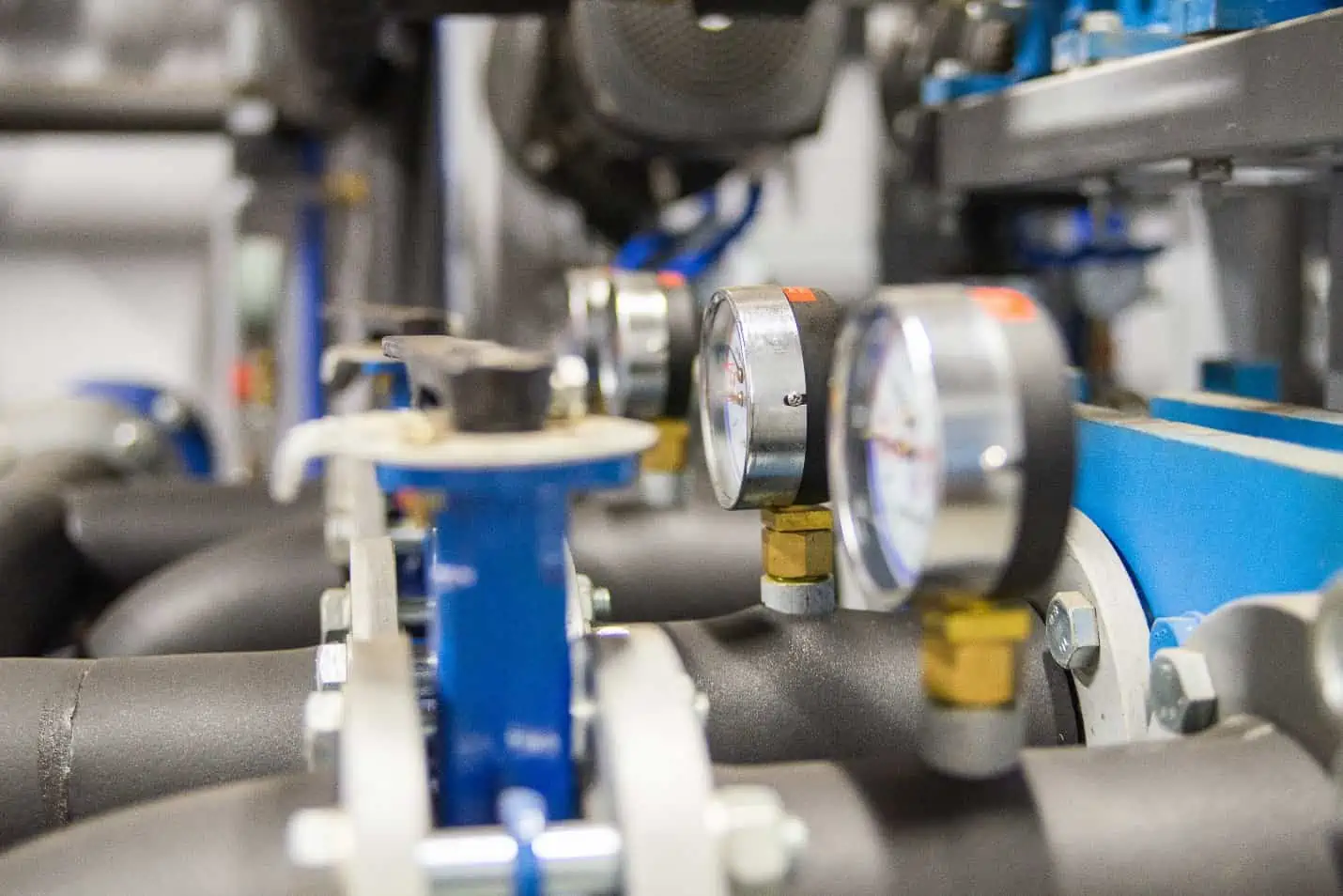
Bernoulli’s equation can determine the flow velocity and rate by measuring the pressure difference between the inlet and the throat. A venturi meter’s high accuracy, low pressure loss, and robust design make it a popular choice for fluid flow measurement in various industries, including oil and gas, chemical, and water treatment plants. Keep reading to learn more about the venturi meter’s design and applications and how it can improve fluid flow measurement accuracy.
Venturi Meter Overview
Basic Principles And Venturi Effect
The Venturi effect is the principle used to determine flow rates in venturi meters and is described by the relationship between the fluid’s pressure and velocity within a constricted passage. When a fluid flows through a constricted part of a pipe, its velocity increases while its pressure decreases.

Elevate Your Engineering With Excel
Advance in Excel with engineering-focused training that equips you with the skills to streamline projects and accelerate your career.
Conversely, as the fluid exits the constriction and enters a wider section, its velocity decreases and pressure increases. This relationship can be expressed mathematically through Bernoulli’s equation and is utilized in venturi meter calculations.
Design And Parts
A venturi meter consists of three essential parts: the inlet or converging section, the throat, and the outlet or diverging section.
- Inlet (Converging Section): This section has a relatively larger diameter and converging shape that helps gradually reduce the cross-sectional area of the fluid passage.
- Throat: The narrowest part of the Venturi meter, and the location where the fluid’s velocity reaches its maximum and pressure reaches its minimum.
- Outlet (Diverging Section): A diverging section where the fluid’s velocity decreases and pressure recuperates.
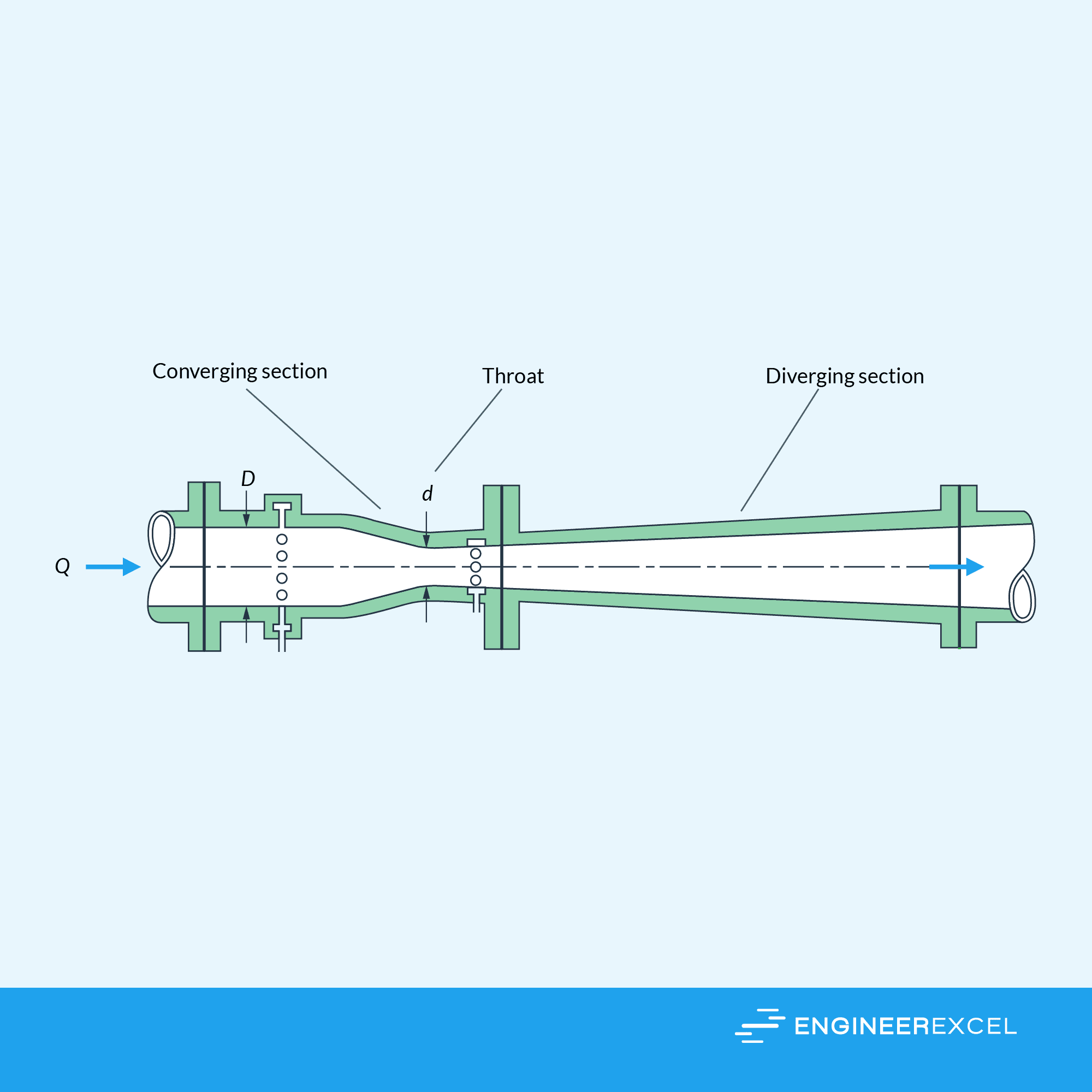
These components work together to create the pressure difference and determine the fluid flow rate based on the known dimensions of the venturi tubes and pressure measurements.
Advantages And Disadvantages
Advantages:
- High accuracy and repeatability in flow rate measurements
- Non-intrusive design that doesn’t require moving parts
- Can handle a wide range of fluid types, including liquids, gases, and slurries
- Low pressure loss, as the pressure head is mostly recovered
- High durability with low maintenance requirements
Disadvantages:
- Requires upstream and downstream straight pipe runs for accurate measurements
- Large size and higher cost compared to alternative flow meter technologies
- Potential for blockages or fouling in applications with dirty or particle-laden fluids
- Sensitivity to flow profile disturbances and dependency on fluid properties
How A Venturi Meter Measures Flow
Bernoulli Equation And Conservation Of Mechanical Energy
The venturi meter operates based on the Bernoulli equation, which describes the conservation of mechanical energy in a flowing fluid. It states that the total energy (sum of pressure, kinetic, and potential energy) along a streamline is constant for an incompressible and steady flow. Mathematically, it is expressed as:

Here, P represents pressure, ρ is the fluid density, v is the flow velocity, z is the height from a reference plane, and subscripts 1 and 2 refer to points before and after the flow passes through the Venturi meter.
Mass Continuity And Fluid Dynamics
The principle of mass continuity dictates that the mass flow rate through every flow cross-section should remain constant. This means that when the fluid passes through a constricted part where the diameter decreases (called the throat), the velocity of the fluid increases while conserving mass flow rate. For an incompressible fluid in a Venturi meter, this is represented by:

Where A is the area of the cross-section.
Applying both the Bernoulli equation and mass continuity in the venturi meter, we can derive the equation for the flow rate:
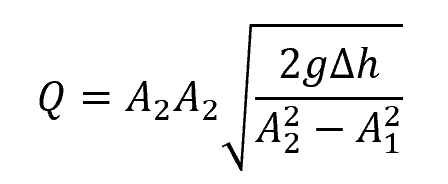
Q is the flow rate, and Δh is the pressure difference between the inlet and throat.
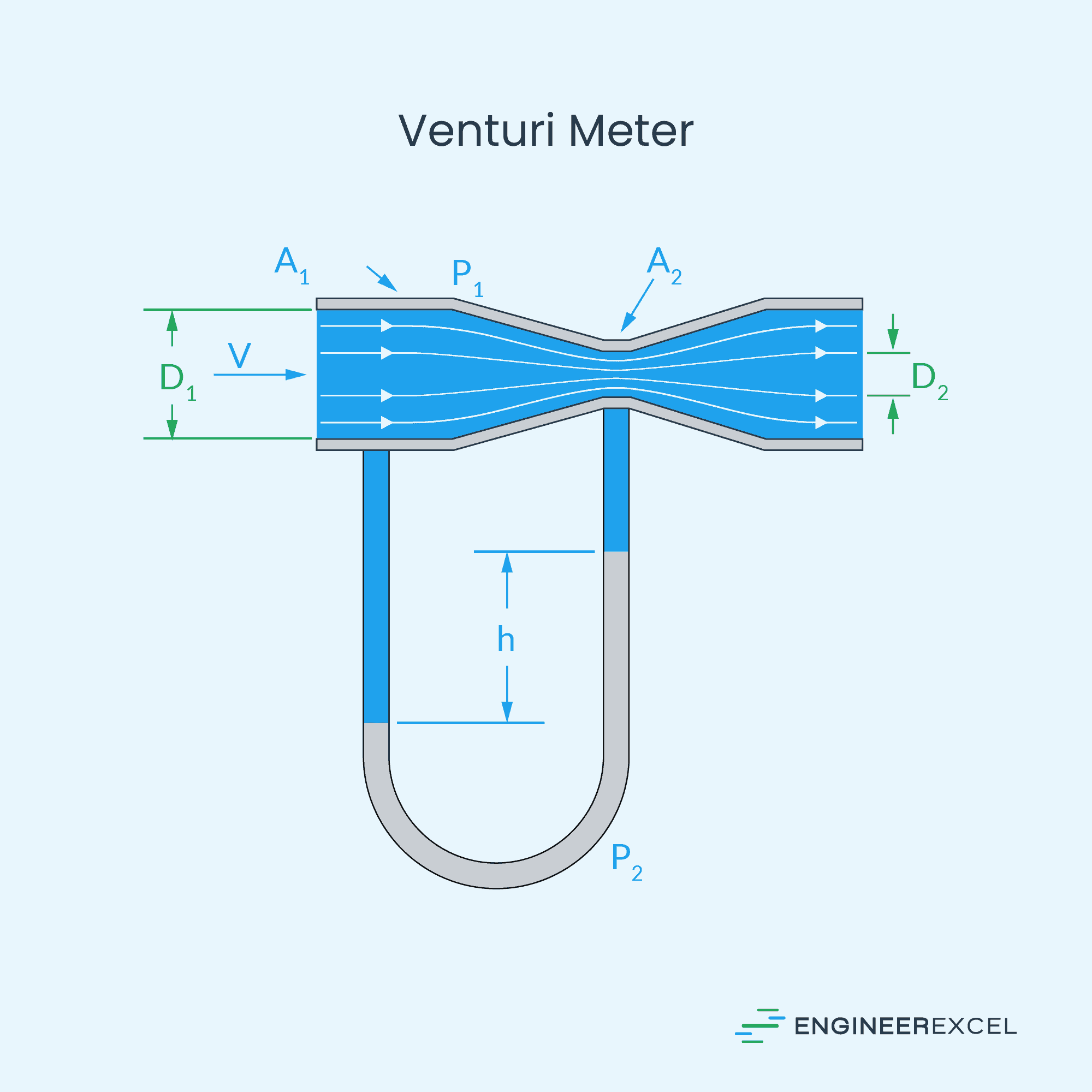
Pressure Measurement And Manometer
The pressure difference Δh is obtained using a manometer connected at the inlet and throat of the venturi meter. The manometer measures the pressure difference between two points in terms of the fluid column height. This pressure difference is directly proportional to the square of the flow velocity through the meter. And thus, the flow rate can be calculated.
Venturi Meter Flow Applications
Liquids, Gases, And Steam
Venturi meters are widely used to measure the flow of various fluids, including liquids, gases, and steam. They provide accurate and reliable flow measurements due to their simple design and lack of moving parts, making them suitable for a range of applications:
- Liquids: Venturi meters effectively measure the flow of both low and high-viscosity liquids, which can include water, oil, and other industrial fluids.
- Gases: Gas flow measurement is common in natural gas distribution, airflow control, and various chemical processes.
- Steam: In industries that rely on steam for various processes, such as power plants and food processing, venturi meters accurately measure steam flow rates.
Water And Viscous Liquids
Venturi meters are especially useful for measuring water flow and viscous liquids, including wastewater, lubricants, and mud. Their advantages in these applications include:
- Low pressure loss: Venturi meters have minimal impact on the pressure of the flowing liquid, making them suitable for low-pressure systems.
- High accuracy: These meters provide high accuracy in flow measurement, even in cases of varying viscosity or changing flow rates.
- Low maintenance: Venturi meters require very little maintenance due to their lack of moving parts, which can be beneficial in maintaining the efficiency of systems that involve water and viscous liquids.
Chemical
In the chemical industry, venturi meters are used for measuring and controlling the flow of various chemicals, acids, and bases. Here are some key reasons they are chosen for these applications:
- Corrosion resistance: Venturi meters constructed from materials like stainless steel, plastic, and glass can withstand corrosive fluids, ensuring longevity and reliable measurements.
- Wide range of sizes: These meters are available in various sizes, allowing them to accommodate different flow rates and pipe diameters in chemical processes.
Slurry Pumping
Slurry pumping, which involves the transportation of solid particles suspended in liquid, can be accurately measured using venturi meters. Some benefits of using venturi meters in slurry service applications include the following:
- Abrasion resistance: Venturi meters constructed from abrasion-resistant materials can handle the erosive nature of slurries without compromising accuracy.
- Handling of solids: The meters’ straightforward design allows solids to pass through with minimal interference, ensuring accurate flow measurement.
- Low maintenance: Minimal moving parts reduce the risk of failure caused by the presence of solid particles, allowing the venturi meter to stay operational with low maintenance requirements.
Installation And Materials
Pipeline And Cross-Sectional Area
When installing a Venturi meter, choosing the proper pipeline and cross-sectional area is essential. This ensures accuracy in measuring the flow rate of a fluid.
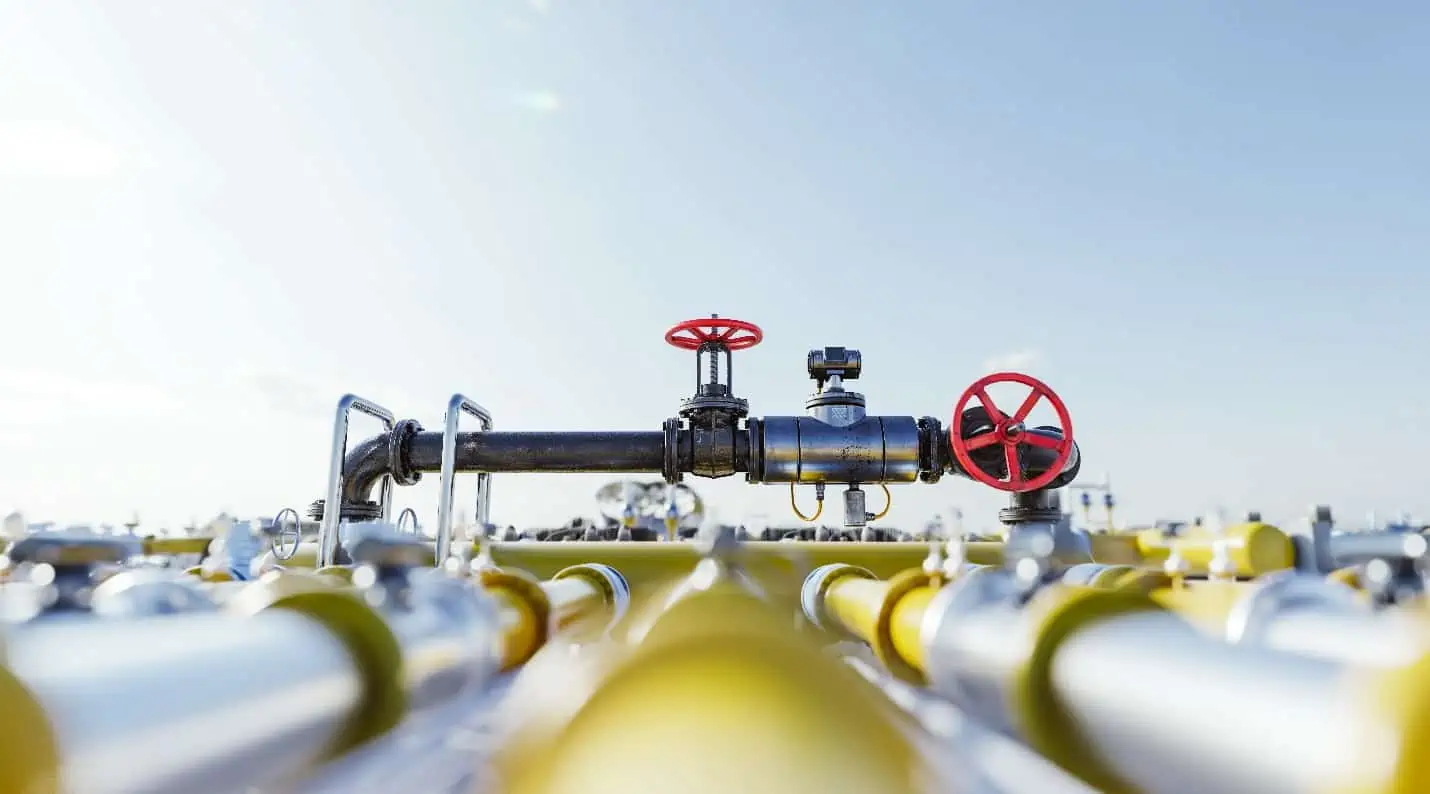
Choose a straight section of the pipeline with no bends, valves, or fittings for about ten times the pipe diameter upstream and five times the pipe diameter downstream of the meter.
Considering the pipe’s cross-sectional area is crucial, as it directly influences the reading. A larger area will lead to a decreased pressure difference, while a smaller area will result in an increased pressure difference.
Material Selection: Cast Iron, Steel, And Other Metals
Various materials can be used for constructing a Venturi meter. The choice depends on cost, durability, and the measured fluid.
- Cast Iron: Cast iron is a popular choice due to its affordability and durability. It can withstand high temperatures and has some corrosion resistance. However, other materials may be a better choice for highly corrosive or abrasive fluids.
Pros:
- Economical
- Durable
- Good temperature resistance
Cons:
- Not suitable for highly corrosive fluids
- Stainless Steel: Stainless steel is another common choice for Venturi meters due to its high strength and durability. Stainless steel provides better corrosion resistance than cast iron, making it suitable for a broader range of fluids.
Pros:
- Strong and durable
- Corrosion-resistant
Cons:
- More expensive than cast iron
- Other Metals: For specific applications, various other metals like brass, bronze, or nickel alloys may be used. These materials can offer better corrosion resistance or other properties required for a particular application.
Pros:
- Tailored for specific applications and fluid types
Cons:
- More expensive than cast iron or steel
When selecting the material, consider the fluid’s temperature, chemical composition, and abrasive properties. The appropriate material choice ensures better performance, longevity, and accuracy of the Venturi meter.
